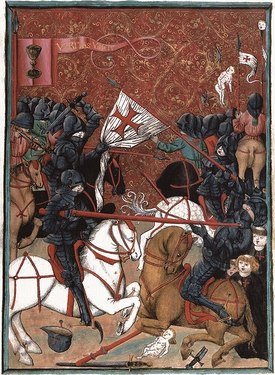Conquest of Joanusterra
This article is a work-in-progress because it is incomplete and pending further input from an author. Note: The contents of this article are not considered canonical and may be inaccurate. Please comment on this article's talk page to share your input, comments and questions. |
| War of Errantry | |||||||
|---|---|---|---|---|---|---|---|
 Battle of Catholic crusaders and East Goths Toubourg Codex, c. 1500 | |||||||
| |||||||
| Belligerents | |||||||
|
|
| ||||||
| Commanders and leaders | |||||||
The Conquest of Joanusterra, formally known as the War of Errantry (Burgoignesc: Guerre errante, Gothic: Irrender Krieg), was a Crusade called by Pope Callixtus III against Gothica which lasted from 1458-1474. The sixteen year Crusade, which followed the failed Ænglish Crusade against Gothica, ended in victory for the crusaders and resulted in the creation of the marcher realm Joanusterra through the near-universal deposal of Gothic nobility from Eastern Gothica and forceful conversion of the East Goths to Levantine Catholicism.
The largely Deric crusaders were led by an array of lesser nobles who amassed with their retinues in Ænglasmarch in early 1458. The crusaders led by Count of Estia Joanus de Martigueux entered Gothica from the east by the Vollardic Mountains, headed for the city of Koop. Early crusaders successes culminated in the decisive Battle of Willersthal which saw numerically superior Gothic forces destroyed, outmaneuvered and outclassed by de Martigueux's mounted heavy cavalry forces. Subsequent major battles were few, much of Gothica's principal leadership having been killed or captured at Willersthal. Sieges were common, as Gothic lords attempted to hide out the conquest in their walled castles. Some Gothic lords like Eberhard the Sentinel and Markvart von Talerbeck were christened voluntarily and joined the ranks of the crusaders. The Order of the Knights of the Oblong Table was officially formed in 1462 as an inner circle of most trusted allies to de Martigueux. What is today the modern Yonderian Collinebourg County was conquered at around this time, and de Martigueux let his castle Collinebourg be built on a hill overlooking the Peritonne River in 1464, from which the future capital of Yonderre Collinebourg soon grew out.
Beginning in 1470, the crusaders under de Martigueux once more amassed a major force to assault westward towards the Donne River. A number of major sieges occured, notably that of Donnebourg which lasted almost two years from 1471-1473. With the Gothic nobility in East Gothica unseated and their lands occupied, de Martigueux announced that the crusaders stood victorious and that their crusade had reached its end. A period of rebuilding and further proselytising followed the sixteen years of conquest. de Martigueux divided the conquered lands between the Knights of the Oblong Table in a fashion which laid out the boundaries of the modern Counties of Yonderre. Petitions from de Martigueux to let his new realm be absorbed into the Holy Levantine Empire were denied by orders of Pope Sixtus IV to deny the Emperor more power. What followed instead was the signing of the Treaty for the guarantee of Joanus' Land between de Martigueux and Pope Alexander VI in 1494, which established Joanusterra as an independent realm.
The consequences of the war for the East Goths were immense; not only had they been conquered and forcefully converted to Levantine Catholicism, they had also suffered sixteen years of warfare and instability causing poverty and famine in the region, ultimately leading to widespread banditry, refugee crises and ultimately depopulation. The War of Errantry was also notable for its extensive use of early handheld firearms such as hand cannons, as well as wagon forts.